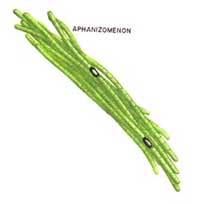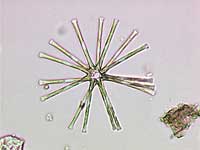Waste water treatment by aquatic plants
Treat wastewater with algae

Algae Aphanizomenon
Algae are groups of microorganisms capable of photosynthesis, which can be in the form of unicellular (some species are smaller than some bacteria), or multicellular (like seaweed species, up to a few meters long) . Plant classifiers rely on the types of products that the algae synthesize and contain in their cells, the types of algae pigments to classify them.
Algae have a fast growth rate, withstand changes in the environment, are able to grow in wastewater, have high nutritional and protein values, so people take advantage of these characteristics of algae to:
1. Waste water treatment and nutrient reuse. Biological activities in algae ponds take away the organic matter and nutrients of waste water converted into nutrients in algae cells through photosynthesis. Most types of urban wastewater, agriculture, animal manure can be treated by algae pond system.
2. Turn solar energy into energy in living organisms. Algae use solar energy to photosynthesize sugar, starch . Therefore the use of algae to treat waste water is considered an effective method to convert solar energy into energy of the body. living.

Asterionlla algae
3. Kill pathogens. Through the treatment of wastewater by algae, pathogens in wastewater will be destroyed due to the following factors:
-
The pH change in the day of the pond is algae caused by photosynthesis
-
The toxins secrete from algae cells
-
And the exposure of pathogens to solar radiation (UV)
Usually people combine wastewater treatment and produce and harvest algae to remove organic matter in wastewater. However, algae are difficult to harvest (due to their very small size), most of them have thick cell walls so animals are very difficult to digest, often contaminated by heavy metals, pesticides, and other pathogens. in waste water.
The reactions in the pond are mainly algae "symbiotic activity between algae and bacteria".

Essential elements for algae treatment

Ceratium algae
Nutrient: Ammonia is the main source of protein for algae to synthesize cellular proteins through photosynthesis. Phosphorus, Magnesium and Potassium are also nutrients that affect the growth of algae. The ratio of P, Mg and K in algae cells is 1.5: 1: 0.5.
Depth of algae: depth of algae pond is selected based on optimizing the ability of light source in the synthesis of algae. According to the theoretical basis, the maximum depth of the algae pond is about 4.5 ¸ 5 inches (12.5cm). But experiments on the model show that the optimal depth is in the range of 8 ¸ 10 inches (20 ¸ 25cm). However, in actual production, the depth of the algae pond should be greater than 20cm (and within 40 ¸ 50 cm) to create the time to store waste in the algae pond appropriately and except the loss of volume due to sedimentation. .
Survival time of pond wastewater (HRT): the optimal life-time of wastewater is the time required for nutrients in wastewater to be converted into nutrients in algae cells. Often, people choose to save the time of wastewater in ponds larger than 1.8 days and less than 8 days.

Chlamydomonas algae
Amount of loaded BOD for algae: amount of loaded BOD for algae affects algae productivity because if the BOD load is too high, the environment in the algae pond will become anaerobic affecting the symbiosis of algae and bacteria. Some experiments in Thailand show that in tropical conditions algae depth is 0.35 m, HRT is 1.5 days and the amount of BOD loaded is 336 kg / (ha / day) which is optimal for ponds. algae and algae yield reached 390 kg / (ha / day).
Stirring and circulation: the process of mixing in algae ponds is necessary to prevent algae cells from settling to the bottom and enabling the nutrients to contact the algae to promote photosynthesis. In large algae ponds, the mixture also prevents the process of stratification in algae and anaerobic ponds in algae pond bottom. But mixing also creates disadvantages because it causes the sediment to float up and prevent the diffusion of light into the algae pond. Moraine and colleagues (1979) suggested that the flow rate in algae ponds should only be about 5 cm / s. Circulation helps the algae pond to retain active bacteria and algae cells; helps the ventilation process, accelerating reactions in algae ponds.
Harvesting algae: algae can be harvested by mesh or comb paper, harvested by creating flakes or floating, harvesting biology with fishes eating plants and invertebrates eating algae.
Treatment of wastewater by large-sized aquatic plants

Algae Dinobryon
Phytoplankton are plants that grow in water, which can cause some disadvantages for humans due to their rapid development and wide distribution. However, taking advantage of them to treat wastewater, composting, food for humans and livestock can reduce the disadvantages caused by them, but also earn more profits.
Types of main aquatic plants
Aquatic plants live submerged: this type of aquatic plant grows under water and grows only in water sources with enough light. They cause harms such as increasing the turbidity of the water, preventing the diffusion of light into the water. Therefore these aquatic plants are not effective in cleaning up waste.
Aquatic plants live floating: the roots of this plant do not cling to the soil but float over the water, its body and leaves grow on the water. It floats on the water according to the wind and the water. Their roots allow bacteria to attach to decompose waste.
Floating aquatic plants : this aquatic plant has roots attached to the soil but the stem and leaves grow on the water. This type usually lives in places with stable tidal regime.
Some typical aquatic plants
Species
Common name
Science name
Aquatic plants live submerged
Hydrilla Hydrilla verticillata Water milfoil Myriophyllum spicatum Blyxa Blyxa aubertii
Floating living aquatic plants float
Eichhornia crassipes Wolfia arrhiga Duckweed Pistia stratiotes Salvinia Salvinia spp
Living aquatic plants live well
CattailsTypha sppBulrushScirpus sppSPhuongites communis
The task of phytoplankton in processing systems
Body part
Mission
Roots and / or stalks As a rack for bacteria to grow Filter and absorb solids Body and / or leaves on the water or above the surface of water Handling Reduce the exchange between water and atmosphere Transfer oxygen from leaves to roots
Some reference values to design Luc Binh pond for wastewater treatment
Parameter
Design data
Waste water quality
post-processing
Raw sewage
- Water retention time
> 50 days
BOD5
- Flow of waste water
200 m3 / (ha.day)
TSS
- Maximum depth
- Area of a pond unit
0.4 ha
- Flow of organic load
- Long ratio: wide of the pond
> 3: 1
Waste water through level I treatment
- Water retention time
> 6 days
BOD5
- Flow of waste water
800 m3 / (ha.day)
TSS
- Maximum depth
0.91 m
TP
- Area of a pond unit
0.4 ha
TN
- Flow of organic load
- Long ratio: wide of the pond
> 3: 1



Algae Eulgena
Pariditrum algae
Algae Synura
Le Hoang Viet - Cited by Chongrak Polprasert (1989)
- New technology to treat industrial wastewater into clean water
- Generators from waste water
- Solution to kill mulberry flowers on Till river
- Waste water treatment using anaerobic digestion technology
- Utilize waste cooking oil to produce electricity
- Waste treatment solution for hospitals in Vietnam
- What to do when drinking water is contaminated
- $ 140 million to build the largest waste treatment plant in Vietnam
- Waste water treatment by slag
- 6 facts that make you change the way you think about using water
- Detecting new carnivorous plants
- New technology to treat human waste by sea water
 'Barefoot engineer' invents a pipeless pump
'Barefoot engineer' invents a pipeless pump Process of handling dead pigs due to disease
Process of handling dead pigs due to disease Radiometer
Radiometer Warp Engine: Technology brings us closer to the speed of light
Warp Engine: Technology brings us closer to the speed of light